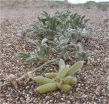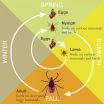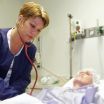(Press-News.org) A Simon Fraser University researcher has uncovered what may be the first quantified evidence demonstrating a relationship between upright locomotion and spinal health.
Scientists have long pondered whether there is a link between walking upright and back problems, since people have more back pain than other primates such as chimpanzees, with whom we share 98 per cent of our DNA.
Kimberly Plomp, a post-doctoral fellow and biological anthropologist, spent the past seven years studying ancient bones for the telltale signs of disease and injury that give archaeologists insight into our ancient ancestors' health and lifestyles.
"Evidence of injury and disease on human skeletons provide archaeologists with valuable insight into our ancestors' health and lifestyles and can provide a lot of information about the health of a person or a population," says Plomp, who is working with professor Mark Collard as part of the Human Evolutionary Studies program (HESP).
"For example, in ancient remains we can see evidence of metabolic issues, infectious disease, and trauma related to heavy activities or a rough lifestyle."
Plomp has investigated the relationship between vertebral shape, upright locomotion and human spinal health, using two-dimensional shape analyses of chimpanzee, orangutan and archaeological human vertebrae (the bones that form the spine.)
"We have found that some characteristics of human vertebrae differ in shape between those individuals who has a lesion called a Schmorl's node - a small hernia that can occur in the cartilaginous disc between vertebrae," says Plomp.
"The humans who have Schmorl's nodes tend to have vertebral elements with a shape that is statistically indistinguishable from chimpanzee vertebrae."
Humans and chimpanzees split from a common ancestor about eight to nine million years ago, and at some point after that split it is thought that human lineage evolved to be bipedal, moving on two rear legs, while the chimpanzees evolved to be knuckle-walkers, notes Plomp.
Plomp says her findings show that the vertebrae of humans with disc problems are closer in shape to those of our closest ape relatives, the chimpanzee, than are the vertebrae of humans without disc problems.
"As evolution occurred our vertebrae would have changed as we evolved, from using some form of quadrupedal locomotion, using four legs, to bipedalism, using two legs," she says.
However, she adds, evolution isn't perfect and some vertebral characteristics, such as those identified as being similar to chimpanzees, may have remained within the human 'blueprint' and result in some people having vertebrae that are less able to withstand the pressures of bipedal walking.
"In short, our study suggests that the pathological vertebrae of some people may be less well adapted for walking upright," says Plomp.
Plomp and Collard call this the "ancestral shape hypothesis" and plan further investigation using 3D shape studies of ancient and modern human and primate vertebrae, and include other spinal diseases such as osteoarthritis.
She says the findings not only have potential clinical implications but also illustrate the benefits of bringing the tools of evolutionary biology to bear on problems in medicine and public health.
Her article, "The ancestral shape hypothesis: An evolutionary explanation for the occurrence of intervertebral disc herniation in humans," has been published in the peer-reviewed journal BMC Evolutionary Biology.
INFORMATION:
Other team members include researchers Darlene Weston from UBC, Una Strand Viðarsdóttir from the University of Iceland, and Keith Dobney from the University of Aberdeen.
Funding for her research has come from the Social Sciences and Humanities Research Council, Canada Research Chairs Program, Canada Foundation for Innovation, British Columbia Knowledge Development Fund, MITACS Elevate Fellowship, and SFU.
As Canada's engaged university, SFU is defined by its dynamic integration of innovative education, cutting-edge research and far-reaching community engagement. SFU was founded almost 50 years ago with a mission to be a different kind of university--to bring an interdisciplinary approach to learning, embrace bold initiatives, and engage with communities near and far. Today, SFU is a leader amongst Canada's comprehensive research universities and is ranked one of the top universities in the world under 50 years of age. With campuses in British Columbia's three largest cities--Vancouver, Surrey and Burnaby--SFU has eight faculties, delivers almost 150 programs to over 30,000 students, and boasts more than 130,000 alumni in 130 countries around the world.
Simon Fraser University: Engaging Students. Engaging Research. Engaging Communities.
Simon Fraser University
University Communications,
778.782.3210
http://www.sfu.ca/university-communications
Contact:
Kimberly Plomp kplomp@sfu.ca
Marianne Meadahl, University Communications, 778.782.9017; Marianne_Meadahl@sfu.ca
Photos for download: http://at.sfu.ca/ikNgWF
Paper: http://www.biomedcentral.com/
Beginning in the 1880s, coastal dunes in the United States were planted with European beachgrass (Ammophila arenaria) in an attempt to hold the sand in place and prevent it from migrating. The grass did the job it was brought in to do. As it trapped sand in its deep roots, the dunes at the beachfront grew higher and steeper and less sand moved inland. But, like many attempts to control nature, this one had unintended consequences.
Although dunes may look barren, they are actually reservoirs of biodiversity. "If you're a plant lover, the sand dunes are just spectacular," ...
(Millbrook, NY) The month of May brings many things, among them Mother's Day, tulips, and Lyme Disease Awareness campaigns. But according to Dr. Richard S. Ostfeld, a disease ecologist at the Cary Institute of Ecosystem Studies in Millbrook, NY, if we want to get a leg up on tick-borne illness we need to become vigilant earlier in the season.
In New York State, the blacklegged ticks that carry Lyme disease and other pathogens are already active in late April. Ostfeld explains: "For more than two decades, we've been monitoring tick activity in the Hudson Valley region ...
KNOXVILLE--The monk parakeets that have invaded Europe and North America over the last 40-50 years fortifying their massive communal nests atop utility poles in many urban areas appear to have originated from the same small area in South America, according to a new study.
Considered one of the best speaking parrots, thousands of these bright green birds have been imported for the pet trade, and feral populations began appearing in the United States in the 1960s and in Europe in the 1980s. And yet, these two independent invasions--in the United States and in Europe--appear ...
(SACRAMENTO, Calif.) -- UC Davis investigators have settled a long-standing controversy surrounding the molecular basis of an inherited disorder that historically affected Ashkenazi Jews from Eastern Europe but now also arises in other populations of Semitic descent, particularly families from Saudi Arabia.
Through a series of elegant experiments, the researchers uncovered the biochemical underpinnings of Canavan disease, a type of leukodystrophy that is an incurable and progressively fatal neurological condition. The UC Davis team identified an abnormally high buildup ...
COLUMBUS, Ohio - A national survey released today by The Ohio State University Wexner Medical Center shows that most women don't know the risks or symptoms females face when it comes to having a stroke.
The survey of 1,000 women released in time for Stroke Awareness Month in May found that only 11 percent of women could correctly identify pregnancy, lupus, migraine headaches and oral contraception or hormone replacement therapy as female-specific stroke risks.
The survey also found that only 10 percent were aware that hiccups combined with atypical chest pain are among ...
Astronomers using the National Science Foundation's Very Large Array (VLA) have found a long-sought "missing link" between supernova explosions that generate gamma-ray bursts (GRBs) and those that don't. The scientists found that a stellar explosion seen in 2012 has many characteristics expected of one that generates a powerful burst of gamma rays, yet no such burst occurred.
"This is a striking result that provides a key insight about the mechanism underlying these explosions," said Sayan Chakraborti, of the Harvard-Smithsonian Center for Astrophysics (CfA). "This object ...
Older women with urinary tract infections who are taking the commonly prescribed antibiotic nitrofurantoin are more likely to experience treatment failure, resulting in a second antibiotic prescription or a hospital visit, than if they received another antibiotic, according to research in CMAJ (Canadian Medical Association Journal).
More than 25% of older adults have low kidney function, and bladder infections are common. Nitrofurantoin is one of the most commonly prescribed antibiotics for bladder and other urinary tract infections, with an estimated 25 million prescriptions ...
DURHAM, N.C. - Repeated alcohol exposure during adolescence results in long-lasting changes in the region of the brain that controls learning and memory, according to a research team at Duke Medicine that used a rodent model as a surrogate for humans.
The study, published April 27 in the journal Alcoholism: Clinical & Experimental Research, provides new insights at the cellular level for how alcohol exposure during adolescence, before the brain is fully developed, can result in cellular and synaptic abnormalities that have enduring, detrimental effects on behavior.
"In ...
April 27, 2015--Researchers at Columbia University's Mailman School of Public Health looked at the frequency of nonmedical prescription opioid use and the risk of heroin-related behaviors and found that past-year heroin use rose among individuals taking opioids like oxycontin and these increases varied by race and ethnicity. The most significant rise in heroin use was among Hispanics and non-Hispanic whites, where the rate of heroin use for the latter group increased by 75 percent in 2008-2011 compared to earlier years. Findings are online in the journal Drug and Alcohol ...
Determining whether your snoring is merely annoying, or crosses the threshold into a life-threatening problem, isn't convenient or cheap.
The gold standard for diagnosing sleep apnea -- a disease which affects roughly 1 in 13 Americans -- requires an overnight hospital stay and costs thousands of dollars. The patient sleeps in a strange bed, gets hooked up to a tangle of wires, and undergoes an intensive polysomnography test to count how many times a night he or she struggles to breathe.
By contrast, a new app developed at the University of Washington uses a smartphone ...



